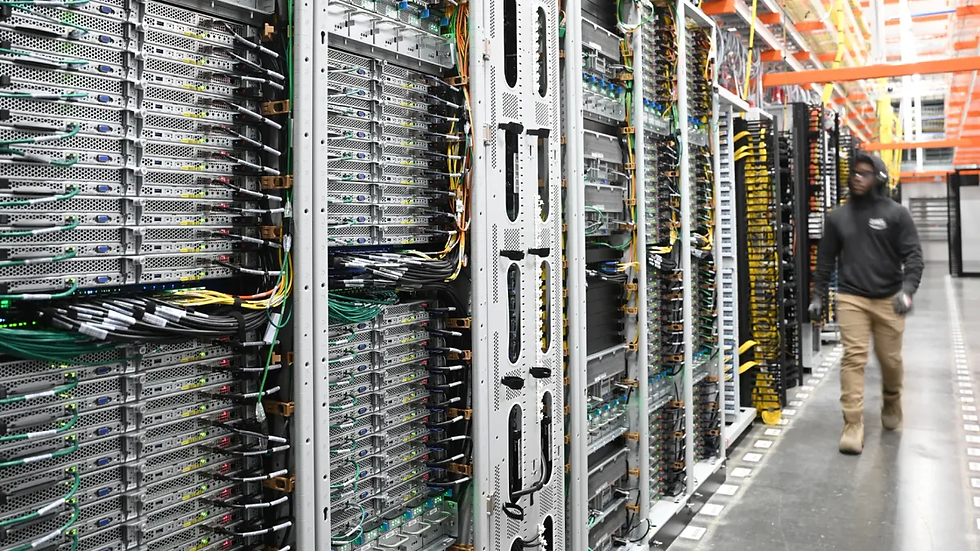The Hidden Cost of Data Centers: How Amazon’s Largest Data Center Is Draining Indiana’s Water Resources
- Ethan Carter

- Sep 28
- 5 min read

Data centers are the backbone of the modern digital economy, powering everything from cloud computing to AI startups. However, their massive energy and water demands are raising serious environmental and social concerns, particularly in small towns like New Carlisle, Indiana. This article dives deep into the complex realities behind data center development, focusing on Amazon’s largest data center in America and its impact on local water resources, community well-being, and regional politics.
What Exactly Is a Data Center? — Core Definition and Common Misconceptions

A data center is a facility that houses computer servers and networking equipment used to store, process, and distribute vast amounts of data. Often viewed simply as “tech buildings,” these centers are in fact large industrial complexes that require enormous amounts of electricity and water, especially for cooling purposes. A common misconception is that data centers are just passive storage units; in reality, they operate at a scale that profoundly affects local resources and infrastructure.
Amazon’s data center in New Carlisle exemplifies this industrial scale. Located on a 1,200-acre expanse of former cornfield, the facility will require 2.2 gigawatts of electricity—enough to power a million homes—and will cool hundreds of thousands of computer chips with millions of gallons of groundwater annually On 1,200-acre expanse of farmland. Local residents have documented the facility’s impact on their wells and ponds, noting that the site “guzzles millions of gallons of water from the Kankakee aquifer” to support operations Amazon is building their largest data center in Indiana.
Why Are Data Centers So Important? — Their Impact and Value

Data centers are critical to supporting the digital economy, enabling cloud computing, AI advancements, and internet services on a global scale. For towns and states, hosting a data center offers economic incentives such as job creation, infrastructure investment, and increased tax revenues. Indiana lawmakers have extended sales and use tax exemptions to equipment purchases under House Bill 1405, drawing tech giants to build massive data centers in the state State investigates groundwater issues near Amazon, GM projects in St. Joseph County.
However, the purported economic benefits are often heavily outweighed by environmental degradation and social costs. Local residents in New Carlisle face rising electric bills, health concerns, and a severe depletion of groundwater, which they rely on for drinking and irrigation County sets water usage limit on Amazon, GM projects. In Michigan City, a similar data center tax abatement deal promised 30 full-time jobs and $26 million in incentives over 40 years, but citizens have questioned whether short-term gains justify long-term resource depletion.
The Evolution of Data Centers: From Past to Present
Data centers have grown exponentially in size and energy consumption over the past decade, driven by surging demand for cloud computing and AI. Indiana has become a hotspot for development, with over 30 centers in various stages of construction or operation, including facilities owned by Meta, Google, and Microsoft.
Early facilities used on-site diesel generators or coal-powered plants, creating localized air pollution. As computational loads increased, operators turned to water-cooled systems, triggering fresh environmental challenges. South Bend Tribune reports that dewatering for Amazon’s New Carlisle data center has “significantly lowered water tables,” leaving residents’ wells dry and ponds depleted Wells lose water near Amazon GM projects in St. Joseph County. This pattern replicates across Indiana, where aggressive tax breaks and minimal regulatory oversight have fueled a rapid build-out, often at the expense of local ecosystems.
How Data Centers Work: A Step-by-Step Reveal of Their Environmental Impact

Construction and Groundwater Dewatering To prepare stable foundations, large data centers often pump out groundwater—a process called dewatering—for months. In New Carlisle, Amazon’s contractors installed 24-inch pipes to remove millions of gallons, dropping the aquifer level and compromising wells I Live Next To Amazon’s Largest Data Center.
Operational Water Use Data centers generate intense heat that must be dissipated to prevent equipment failure. Traditional cooling towers rely on evaporative systems, consuming up to 10 million gallons per day in extreme cases. Amazon’s New Carlisle facility uses municipal and groundwater sources to cool servers, drawing critical water from the Kankakee aquifer and stressing community supplies.
Energy Demand and Pollution The centers’ 2.2 GW load keeps regional grids under pressure. In areas lacking renewable infrastructure, this demand sustains coal or gas plants, undermining climate goals. Activists in Michigan City warn that fossil fuel plants may remain operational solely to meet data center needs, delaying the transition to cleaner energy.
Tax Incentives and Financial Policies Local utilities and developers lobby for aggressive tax abatements, often shifting costs onto residents. New Carlisle’s county commission initially approved generous breaks for Amazon, prompting backlash when water shortages surfaced. Critics argue that the long-term environmental and social costs far outweigh temporary economic gains.
How to Observe and Respond to Data Center Impacts in Real Life
Community Awareness and Engagement: Residents attending town council meetings in Michigan City successfully pressured officials to publicize water usage limits County sets water usage limit on Amazon, GM projects.
Research and Documentation: Videos and reports—such as those by More Perfect Union—highlight dewatering impacts and mobilize citizens Amazon is building their largest data center in Indiana.
Political Advocacy: Lobbying state legislators to tighten environmental regulations and challenge tax incentives can slow unchecked growth. Indiana residents have called for amendments to House Bill 1405 to require environmental impact assessments.
Coalition Building: Diverse political groups—from rural farmers to urban environmentalists—are uniting to demand equitable water stewardship and responsible corporate practices.
The Future of Data Centers: Opportunities and Challenges

Sustainable Cooling Technologies: Innovations in air cooling, liquid immersion, and recycled water systems promise to cut water use by over 90%.
Renewable Energy Integration: Pairing data centers with on-site solar, wind, and battery storage can decouple operations from fossil fuels.
Stronger Regulatory Frameworks: Proposed bills in Indiana’s legislature aim to mandate water-use reporting and limit dewatering permits in vulnerable aquifers.
Community-Centered Development: Future projects may include community benefit agreements, ensuring local jobs, infrastructure upgrades, and environmental safeguards in exchange for corporate incentives Citation for New Carlisle’s Amazon data center raises environmental concerns.
Without these reforms, the trend toward corporate dominance, environmental depletion, and community disenfranchisement is likely to intensify, replicating New Carlisle’s experience across the Midwest.
Conclusion: Key Takeaways on Data Centers and Their Environmental Impact
Amazon’s massive data center in New Carlisle, Indiana, illustrates the complex interplay between Big Tech, local politics, and environmental resources. While data centers drive the digital economy and deliver economic incentives, their water usage, energy demands, and regulatory leverage often create significant harm to small towns and vulnerable communities. Active community engagement, political accountability, and technological innovation are essential to ensuring that data centers grow sustainably and justly.
Frequently Asked Questions (FAQ)

What is a data center and why does it consume so much water? A data center houses servers that generate heat requiring substantial cooling, often using evaporative systems that consume millions of gallons per day.
How does a data center affect local water supply? Construction dewatering lowers groundwater levels, and operational use draws millions of gallons from aquifers, threatening drinking water and agriculture.
How do data centers compare with other industrial facilities regarding environmental impact? Data centers uniquely combine high electricity and water consumption with intensive cooling requirements, sometimes prolonging reliance on polluting power plants.
Can local communities prevent data center construction? Communities can organize, attend council meetings, demand transparency, and lobby for stronger regulations, though legal and political hurdles remain significant.
What future trends might reduce the environmental impact of data centers? Advances in sustainable cooling, renewable energy integration, and stricter policies offer hope for balancing data growth with environmental stewardship.


